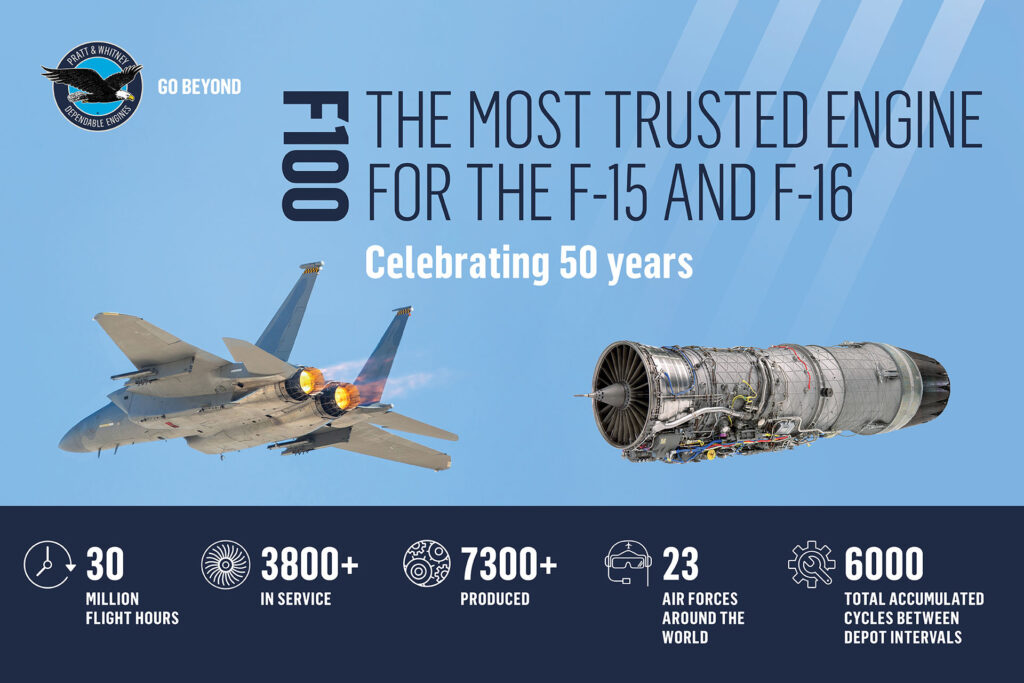Pratt & Whitney F100 Engine Celebrates 50 Years of Service and 30 Million Flight Hours
FARNBOROUGH, July 19. Pratt & Whitney ushered in a new era of fighter engine capabilities in 1972 when the F100-PW-100 powered the first flight of the F-15 Eagle. With a thrust-to-weight ratio 50% higher than its predecessor, the F100 delivered superior capabilities that enabled a new frontier of performance for the F-15 and F-16 aircraft it powered. Since then, the F100 family has grown to include the F100-PW-200, F100-PW-220, and F100-PW-229 variants, each incorporating improved capabilities to deliver increased performance for its operators.

On July 27, 2022, Pratt & Whitney will commemorate 50 years of trusted and reliable service for the F100 engine, which has accumulated more than 30 million engine flight hours.
“The F100 is truly a legendary engine. For 50 years it has set the standard for performance and reliability. It continues to power a majority of the global F-15 and F-16 fleets and we stand ready to offer the F100-PW-229 engine for the F-15EX and F-16 to foreign operators around the globe,” said Josh Goodman, F100 program Senior Director for Pratt & Whitney.
Over the years, the F100 has achieved a number of significant milestones:
1972 – First flight
The Pratt & Whitney F100-PW-100 powered the F-15 Eagle’s first flight on July 27, 1972. Today, the F100 powers every operational USAF F-15 and more than 80% of the global fleet of F-15s.
1983 – Exclusive propulsion provider for Thunderbirds
The United States Air Force Thunderbirds demonstration team transitioned to F100-PW-200-powered F-16 aircraft in 1983. The F100 remains the exclusive propulsion provider for the Thunderbirds with the latest F100-PW-229 powering the current aircraft.
1985 – Advanced upgrades
The F100-PW-220 fielded the first digital electronic control (DEEC) in 1985, which delivers extremely smooth control scheduling that provides pilots the exact power settings they need to optimize performance. The state-of-the-art DEEC system, coupled with enhanced real-time engine monitoring and fault isolation capability, promotes the highest levels of operational readiness for F-15 and F-16 aircraft.
1989 – New variant
The upgraded F100-PW-229, featuring advanced updates and increased thrust, conducted its first flight in 1989. The -229 variant is still in production today and air forces around the world continue to select the F100-PW-229 to power their new fighter aircraft fleets.
2006 – Redefining full life
The F100-PW-229 was the first fighter engine to increase engine depot maintenance interval to 6,000 total accumulated cycles, effectively extending the typical depot interval from 7 to 10 years while providing a 30% life-cycle cost reduction over the life of the engine.
2022 – The F100 achieves 30 million engine flight hours
F100 has been a mainstay in the air force fleets of the United States and operators around the world, providing proven performance and unmatched reliability for more than 30 million engine flight hours. The latest F100 variants incorporate 5th Generation technologies like advanced thermal coatings, improved turbine cooling capabilities, and prognostics and engine health monitoring features that make it the engine of choice for F-15 and F-16 campaigns in Europe, the Middle East, and Asia.
The F100 remains in production, with more than 7,300 F100 engines produced in total and 3,800+ in active service with 23 air forces around the world today.
“The 50th anniversary and 30 million engine flight hour milestones are two more examples of how dependable this propulsion system is, and its continued service with air forces in Europe, Asia, and around the globe prove how important the engine continues to be for our customers’ most critical missions,” said Goodman.




